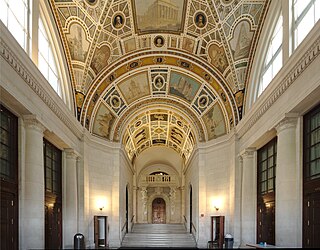
Carnegie Mellon University (CMU) is a private research university in Pittsburgh, Pennsylvania. The institution was established in 1900 by Andrew Carnegie as the Carnegie Technical Schools. In 1912, it became the Carnegie Institute of Technology and began granting four-year degrees. In 1967, it became Carnegie Mellon University through its merger with the Mellon Institute of Industrial Research, founded in 1913 by Andrew Mellon and Richard B. Mellon and formerly a part of the University of Pittsburgh.

The College of Fine Arts (CFA) at Carnegie Mellon University in Pittsburgh, in the U.S. state of Pennsylvania oversees the Schools of Architecture, Art, Design, Drama, and Music along with its associated centers, studios, and galleries.

The Carnegie Museum of Art is an art museum in the Oakland neighborhood of Pittsburgh, Pennsylvania. The museum was originally known as the Department of Fine Arts, Carnegie Institute and was formerly located at what is now the Main Branch of the Carnegie Library of Pittsburgh. The museum's first gallery was opened for public use on November 5, 1895. Over the years, the gallery vastly increased in size, with a new building on Forbes Avenue built in 1907. In 1963, the name was officially changed to Museum of Art, Carnegie Institute. The size of the gallery has tripled over time, and it was officially renamed in 1986 to "Carnegie Museum of Art" to indicate it clearly as one of the four Carnegie Museums.

Scott Draves is an American digital artist. He is the inventor of fractal flames and the leader of the distributed computing project Electric Sheep. He also invented patch-based texture synthesis and published the first implementation of this class of algorithms. He is also a video artist and accomplished VJ.

The Carnegie Mellon School of Art at Carnegie Mellon University in Pittsburgh, Pennsylvania is a degree-granting institution and a division of the Carnegie Mellon College of Fine Arts. The School of Art was preceded by the School of Applied Design, founded in 1906. In 1967, the School of Art separated from the School of Design and became devoted to visual fine arts.

Judith Henry is a New York-based artist that creates multimedia art works exploring interior versus public self. Henry often uses newspapers, telephone books, and film reels. She also uses snapshot photography. After graduating from college, she moved to New York and married artist Jaime Davidovich, with whom she has two daughters. She currently lives in Williamsburg, Brooklyn.

The Miller ICA at Carnegie Mellon University is the contemporary art gallery of Carnegie Mellon University in Pittsburgh, Pennsylvania.
Andrea Grover is an American curator, artist, and writer. She founded the Aurora Picture Show film center in her front room in 1998.
ThePartnership in Education is a non-profit multidisciplinary health literacy and informal science education project based at Duquesne University in Pittsburgh, Pennsylvania. The Partnership in Education produces planetarium shows and other multimedia that focus on topics in health and biology.

Heather Kelley is a media artist, writer and video game designer. She is a co-founder of the Kokoromi experimental game collective, with whom she produces and curates the annual Gamma game event promoting experimental games as creative expression in a social context. She regularly appears as a jury member for several computer gaming festivals. She is also a frequent public speaker at technology events.
Stefan Hechenberger is an Austrian artist and programmer. His works include interactive software, computer vision projects and open-source hardware.
Angela Washko is an American new media artist and facilitator based in New York. She is currently associate professor of art at Carnegie Mellon University. Washko mobilizes communities and creates new forums for discussions of feminism where they do not exist.
Julia Christensen is a multidisciplinary artist and writer based in Oberlin, Ohio. She is Associate Professor of Integrated Media and Chair of the Studio Art Department at Oberlin College.

Smack Mellon is a non-profit arts organization located at 92 Plymouth Street, in Dumbo, Brooklyn. Smack Mellon supports emerging, under-recognized mid-career, and women artists through a highly regarded exhibition program, competitive studio residency, and technical support to realize new and ambitious projects.

Ayanah Moor is a conceptual artist working in print, video, mixed media, and performance. Her work addresses contemporary popular culture by interrogating identity and vernacular aesthetics. Much of her works center on hip-hop culture, American politics, black vernacular and gender performance.

Addie Wagenknecht is an American artist and researcher living in New York City and Liechtenstein. Her work deals primarily with pop culture, feminist theory, new media and open source software and hardware. She frequently works in collectives, which have included Nortd Labs, F.A.T. lab, and Deep Lab. She has received fellowships and residencies from Eyebeam, Mozilla, The Studio for Creative Inquiry at Carnegie Mellon University and CERN.

Morehshin Allahyari is an Iranian media artist, activist, and writer based in New York. Her work questions current political, socio-cultural, and gender norms, particularly exploring the relationship between technology, history, and art activism. Allahyari’s artworks include 3D-printed objects, videos, experimental animation, web art, and publications. As a 2017 Research Resident at Eyebeam, Allahyari also worked on the concept of "Digital Colonialism"; a term she has coined since 2015.
Suzie Silver is an American artist based in Pittsburgh, Pennsylvania, whose artistic focus lies primarily in queer video and performance art. Silver received her MFA from the School of the Art Institute in of Chicago in 1988 and her undergraduate degree from the University of California in 1984 and is currently a professor at Carnegie Mellon University in the School of Art.
Brett Yasko is an American graphic designer. He has designed books, gallery guides, catalogues and exhibitions for numerous artists and institutions.
Edwin "Ed" Mieczkowski was an American visual artist and painter associated with the op-art movement in the U.S. He was one of the co-founders of the Anonima group along with Francis Hewitt and Ernst Benkert in Cleveland in 1960 and taught at the Cleveland Institute of Art from 1959 to 1998.












